These tricks make wind farms more bird-friendly
BBC carries an article about wind turbines which can pose a deadly risk to migrating birds, Caliber.Az reprints the article.
Wind turbines can pose a deadly risk to migrating birds, but there are ways to dramatically reduce crashes.
Across Europe's rugged mountains, a hopeful change is underway: vultures are back. Almost driven into extinction by hunting, poisoning and habitat loss, the huge scavengers are being reintroduced by conservation teams that painstakingly hand-rear birds, supported by pairs of adoptive vulture parents, before releasing them into the wild.
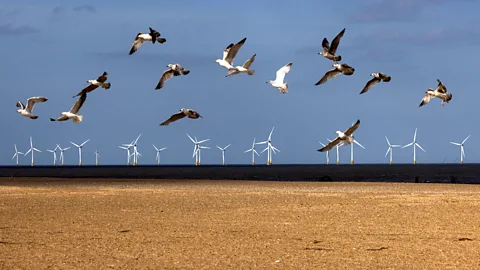
The projects have successfully returned several vulture species to the Alps and the mountains of Andalucia in Spain, and is also restoring populations in other areas of Europe. "Globally, vultures are not doing well," says José Tavares, director of the Vulture Conservation Foundation (VCF). "Europe is the only bright spot. Here, we have been able to revert the trend. Vulture populations have been growing, increasing in distribution, and reoccupying their former range." They have even revived their ancient, seasonal migratory routes, flying from Europe to Africa via the Strait of Gibraltar to overwinter as far south as Mali.
But as the birds take to the skies, a modern threat is endangering their travels: the giant, spinning blades of wind turbines.
Wind farms are expanding in Europe and around the world, as part of the renewable energy revolution – and they are competing with birds for the best winds. Migratory birds, which account for almost 20 per cent of all bird species, are especially at risk. Collisions are particularly high during their seasonal migration, when billions of them are in the sky, and in areas of migratory bottlenecks, such as narrow sea crossings or mountain passes, where winds are funnelled at high speeds. Building wind farms in those windy sites makes sense from an energy-production point of view, but it gets in the way of those travelling birds. (Oil and gas drilling, however, has a worse impact on bird numbers than wind farms, according to a 2024 study).

While wind power is a crucial weapon in the fight against climate change, as Tavares points out, it can clash with efforts to protect and bring back endangered birds.
"A [vulture] needs to be alive for 10 years before it can start to breed," says Tavares. "This makes captive breeding expensive. It seems silly to spend millions of euros trying to save a species, only to put a wind farm or electric pylon in the wrong place – and kill all these years of effort."
A range of solutions in different countries, paired with new research on how birds actually travel and perceive the world, aim to reduce this risk – and help struggling species cope better with our changing energy landscape.
High-visibility cables for vultures
Wind farm collisions can threaten species already in decline, research suggests, and have wider ramifications too, since birds are often vital parts of the ecosystem. Vultures are a powerful illustration of this point: as "obligate scavengers", says Tavares, they are nature's clean-up crew. They feed on the remains of dead animals, eliminating potentially harmful bacteria from the environment, and limiting the spread of diseases such as anthrax and tuberculosis. (Read more about why we should value scavengers).
"If they don't pick up the garbage, you notice it immediately," says Tavares. "Vultures clean up carcasses from the ecosystem. They eat them. They make them disappear. If there are no vultures you start to see carcasses accumulating – and that can cause sanitary problems. They are a very efficient and important element of our natural ecosystems."
By the end of the 20th Century, Europe's four species of vultures were close to extinction across much of the continent. Today, due to the dedicated work of conservationists, bearded, cinereous and griffon vulture populations are recovering. But wind turbines, and the swinging, air-traversing cables between them, are making this recovery harder, says Tavares.
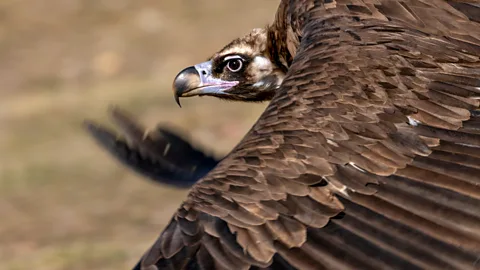
"The wind farms produce electricity, and that electricity needs to be transported to our homes. With wind farms, you've got the rotating blades. If a bird flies against one, the blade will chop them. And if a bird collides with a [cable], they might break a wing or their neck. So, there is this added risk of collision – not only the wind farm itself, but the whole distribution line."
Now, the VCF is working with energy companies to protect vultures from the risks of collision by adding high visibility reflectors and spirals to cables in order to improve the visibility of the power lines. "This is a relatively cheap [solution]," says Tavares. "You can even put them on with drones – without the need interrupt the current."
A 2022 research paper also suggests that mapping the flight path of vultures, by using data from tracked vultures, could help plan wind farms in the Swiss Alps in a way that avoids potential clashes in the first place – by not building them in flight paths.
How birds see the world
Making wind farms safer starts with really understanding how birds see the world, researchers say – and, especially, understanding why they often just don't look where they are going.
"Birds flow through the world," says Graham Martin, emeritus professor at the University of Birmingham in the UK and an expert in avian sensory science. "We humans think the world is in front of us," he says. "We have eyes which look forwards. The world is ahead, and we move into it. Most birds have eyes on the side of their head. They see objects in front of them, and flowing past – and they see the world retreating behind them."
For birds, the world is all around. In some cases, adds Martin, as with mallard ducks, it's above as well. "It's everywhere," he says. "That's a very different perspective from ours. Birds' area of high acuity – the best spatial resolution or the finest detail – is laterally, to the side."
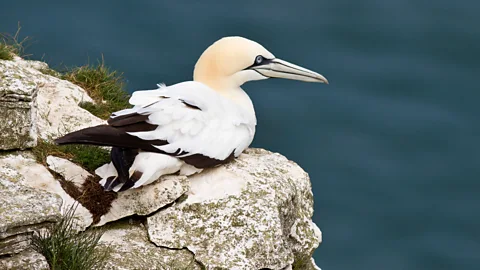
It's this lateral vision, explains Martin, which birds use to detect predators or food. Conversely, their frontal vision has a much lower spatial resolution and "probably only comes into play at close distances", for instance when they want to peck at something, like a worm in the grass.
They do generally have excellent eyesight, with raptors reported to have the highest visual acuity of all animals. The martial eagle, native to sub-Saharan Africa, can spot its prey from an incredible 6 km (3.7 miles) away. But because of their sideways look at the world, that doesn't necessarily mean they can spot a wind farm straight ahead.
If they are on their annual migration, navigating their way across entire continents, they may also just be busy figuring out the bigger route. Birds are in fact impressive navigators, that can learn complex routes, smell their way across oceans, or use sound inaudible to human ears to find their way. These travellers navigate "avian superhighways", which span continents and oceans – using the same flyways their ancestors did, often over thousands of miles for months at a time. But in evolutionary terms, spotting a big obstacle in the sky would not have been an essential skill on that journey, says Martin.
"When birds are on migratory flights," says Martin, "they're probably not paying much attention to what's ahead of them. They may even be blind in the direction in which they're travelling, only occasionally looking up to check what's ahead – as usually they're flying in open airspace."
This helps explain why these sharp-eyed travellers may not notice wind turbines before it's too late.
Reports suggest between 140,000 to 573,000 birds are killed in such collisions every year in the US alone. Some studies put the incidence of global mortalities due to collisions with manmade structures – including wind turbines, communication towers, power lines, and buildings – in the billions, making them one of the most significant causes of human-induced avian mortality worldwide. Avian collisions can also be extremely costly to the renewable energy sector. In the US, avian collisions costs the United States wind energy sector hundreds of millions of dollars every year. (Concerns have also been raised over the impact of offshore wind farms on marine life, especially in terms of their underwater construction noise.
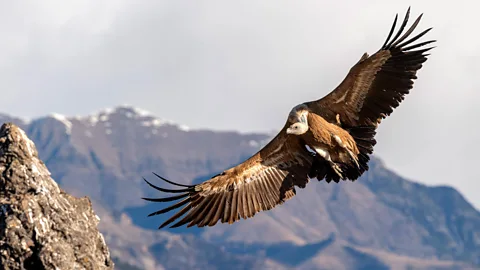
The power of a black blade
One solution is to make the blades of wind turbines much more visible, researchers suggest, so that they stand out and really catch birds' attention.
The Smola wind farm on the west coast of Norway has 68 turbines and covers 18 sq km (7 sq miles), making it one of the largest onshore wind farms in Norway. In 2020, researchers from the Norwegian Institute for Nature Research in Trondheim painted one blade on each turbine black – and found avian fatalities dropped by 70 per cent.
In the UK, Martin and his colleague, Alex Banks, an ornithology specialist at Natural England, have tried another approach. They suggest turbines painted with black and white stripes could be the best way to alert and protect birds, including kittiwakes – a type of seabird that has suffered rapid population declines in recent decades.
"There's a kittiwake colony of about 200 pairs that I monitor," says Banks. "When I go down [to see them], I cross my fingers and hope they can have a good breeding season. They've got a place in my heart, definitely."
He says they face the risk of collision with offshore wind turbines while migrating, but also, once they've settled down to breed: "Kittiwakes, and other species like gannets and great black-backed gulls, nest on the coasts. Every day, they fly out into the marine environment to get food. And that's where we're putting offshore wind turbines. These species have evolved to forage in those areas, and don't expect to find obstacles."
Rather than attempting to contrast the wind turbines against the ever-changing skyscape, says Banks, dividing the blades into thirds of black and white would give an internal contrast, creating a "flickering effect" when rotating.
However, warns Martin, making wind farms more conspicuous can prompt birds to take longer routes to get around a wind turbine field, expending more energy and taking longer to get back to their hungry chicks.
Stripes, reflectors or spinners may also fail to get the birds' attention, if they are just not looking that way. That's why researchers from William and Mary University in Virginia, US, are working on a solution that uses a different signal: sound.
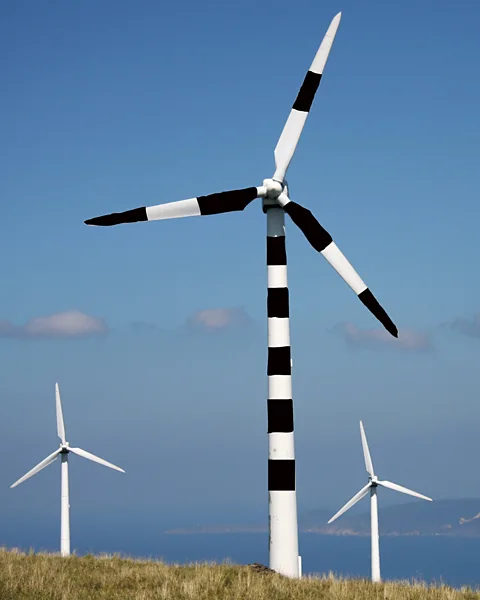
A hissing lighthouse
On the expansive tidal mudflats of the Delmarva Peninsula, on the US eastern shore, tens of thousands migrating birds – sandpipers, plovers, and other shorebirds – stop off to fuel their southward migration, before setting off once again along the Atlantic migratory flyway towards South America.
Timothy Boycott recently took advantage of this heavy migratory traffic to field-test an "acoustic lighthouse" which projects a "hissy" white noise, he says. This alerts migrating birds that there is danger ahead.
Boycott set up speakers at the base of two communications towers which extend into open airspace above surrounding forest and open land, aiming the speakers upward at a 45 degree angle. The sound, which was 4-6kHz, matches the known hearing range of many birds. "We use highly directional speakers to project the sound away from ground level," says Boycott, "to minimise the spread of noise."
The team collected data for three hours a day over six sampling days, recording the bird behaviour on video, with cameras aimed in three zones: approach, passing and flying away from the towers. They reconstructed the birds' flight paths and found they angled their flight trajectories away from the towers.
"In general," says Boycott, "we found that small birds responded most to the acoustic lighthouse, with more pronounced collision avoidance behaviour than medium or large birds. This is perhaps due to smaller birds being able to more quickly adjust their flight path, compared to larger birds."
Boycott is now in talks with energy companies seeking to integrate this approach in new offshore wind developments.
With the renewable energy infrastructure is set to dramatically increase in coming years, the question of how to make it safe for birds and other wildlife is growing more urgent. As the case of the vultures shows, a missing species can affect an entire ecosystem – by potentially removing a clean-up crew, but also, altering predator-prey dynamics or by reducing seed dispersal pollination.
However, Boycott points out that being aware of clashes between energy production and wildlife is already an important step towards solving them.
"We have this chance," says Boycott. "We're going through an energy transition." In his view, this creates an opportunity to develop a sustainable way forward: "Both climate change and biodiversity loss are our main threats – we can't really choose one over the other. They must be addressed in tandem."
The travel emissions it took to report this story were 0kg CO2. The digital emissions from this story are an estimated 1.2g to 3.6g CO2 per page view.








